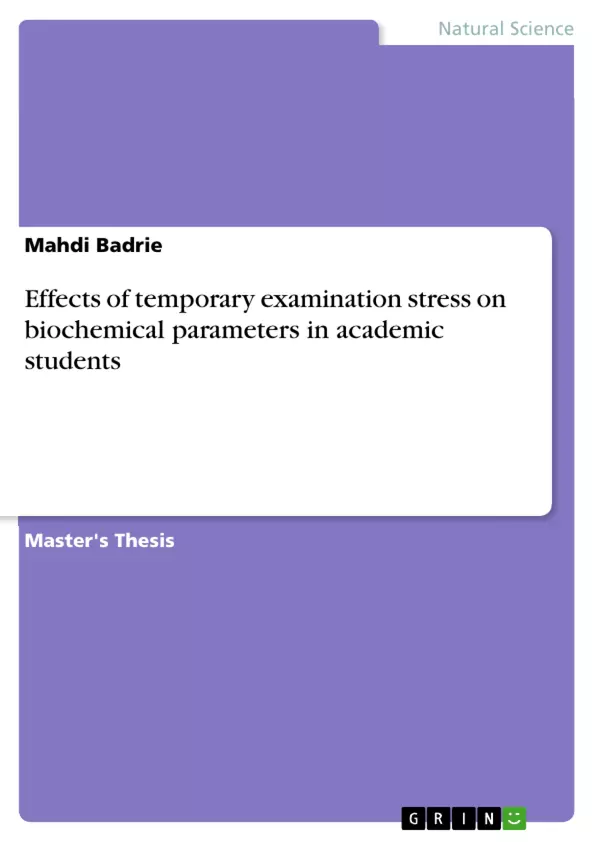The present study was designed to investigate the effect of temporary examination stress on some biochemical parameters in sera of fifty five apparently healthy undergraduate students with age range (19- 24) years and (23.9 ± 2.13 kg/m2) body mass index, they were from University of Baghdad, College of Science; specialty from Mathematic, Physics, Geology, Biotechnology Departments, and also from Al-Esraa College, Medical Analysis Department.
To compare the results, blood samples were obtained from the undergraduate students in two days, the first day was a normal day (Nday) and the second day was after 7-15 days, in the morning before the written exam (Eday). Based on gender, blood types, Rh blood type, exam performance, and the first semester score, the students were classified into several subgroups.
Table of Contents
- Summary
- Introduction
- Review of Literature
- Materials and Methods
- Subjects
- Ethical Considerations
- Chemicals
- Methods
- Results
- Effect of Exam Stress on Biochemical Parameters
- Serum Cortisol
- Fasting Serum Glucose
- Total Serum Protein
- Albumin
- Globulin
- Ceruloplasmin (Cp)
- Cp Concentration
- Cp Oxidase Activity
- Cp Ferroxidase Activity
- Serum Amylase
- Trace Elements (Cu, Fe, and Zn)
- Effect of Blood Types and Rh Blood Types on Biochemical Parameters
- Blood Types
- Rh Blood Types
- Relation Between Biochemical Parameters and Exam Performance
- Discussion
- Conclusion
- References
Objectives and Key Themes
This study aimed to investigate the effect of temporarily examination stress on various biochemical parameters in the sera of undergraduate students. The research sought to understand the potential changes in these parameters in response to exam-related stress. Blood samples were collected from students on a normal day and again before an exam day, allowing for comparisons to be made. The research further explored the impact of various factors, such as gender, blood type, and exam performance, on these biochemical changes. This study provides valuable insights into the physiological and biochemical responses to stress, particularly within an academic context.
- The impact of temporarily examination stress on biochemical parameters in undergraduate students.
- The influence of gender, blood types, and Rh blood types on these biochemical changes.
- The relationship between the studied biochemical parameters and exam performance.
- The significance of different biochemical parameters in understanding stress responses.
- The potential implications of these findings for student well-being and academic performance.
Chapter Summaries
The study begins with an introduction that highlights the importance of understanding the physiological and biochemical responses to stress. The "Review of Literature" chapter delves into existing research on the relationship between stress and various biochemical parameters, providing a theoretical foundation for the study. The "Materials and Methods" section details the study design, subject selection, ethical considerations, chemical reagents, and the procedures used for collecting and analyzing blood samples. The "Results" chapter presents the findings of the study, examining the effects of examination stress on serum cortisol, glucose, protein levels, and other biochemical parameters. The study also explores the impact of blood types, Rh blood types, and exam performance on these biochemical parameters. Finally, the "Discussion" chapter analyzes the findings, highlighting the significant changes observed and offering interpretations and explanations for these results. The "Conclusion" chapter summarizes the key findings of the study and discusses the implications of these findings for future research and student well-being.
Keywords
Examination stress, biochemical parameters, cortisol, serum glucose, total serum protein, albumin, globulin, ceruloplasmin, amylase, trace elements, blood types, Rh blood types, exam performance, undergraduate students.
- Citation du texte
- Mahdi Badrie (Auteur), 2016, Effects of temporary examination stress on biochemical parameters in academic students, Munich, GRIN Verlag, https://www.grin.com/document/347028



